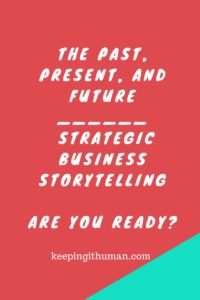In July, I presented to the Corporate Board researchers (based in NY) on strategic business storytelling. We are swimming in data; what we need is actionable information that moves us to act. I talked with the group – mostly economists, data analysts and scientists – about the need to focus on the story behind the data. The present and future of strategic business storytelling is (and has always been) about people and emotions. What is the story the data tells? And how do you want them to think about the data. More importantly, what do we want them to feel about it? That is the big question. Today every company must be a publishing and storytelling company.
The following is part 2 of my interview with the company on the present and future of strategic business storytelling.
*******************************************************************************************
The Present and Future of Strategic Business Storytelling Part 2
By Alex Parkinson, Society for New Communications Research of The Conference Board, and Kathy Klotz-Guest, Business Story Strategist, Speaker, Author, and CEO, Keeping it Human
At the end of September, a new report from the Society for New Communications Research of The Conference Board (SNCR) will look at how corporate communications and marketing are becoming more integrated. The research draws on interviews from experts and practitioners, and will feature case studies from organizations and business leaders who are working on realizing the benefits of integration. In the course of research, I interviewed Kathy Klotz-Guest, CEO of Keeping it Human, (and a founding fellow of SNCR) to understand more about the importance of storytelling to modern marketing. The conversation raised some interesting ideas, so I thought I would share an edited transcript with our readers.
In part 1, we discuss how businesses can start to build an effective storytelling culture. In part 2, I chat about corporate leaders in business storytelling.



